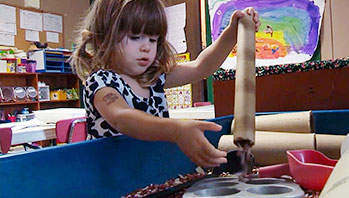- empty plastic yogurt cups, plastic cups, and other small plastic containers
- pieces of cardboard (optional)
- small sand shovels
- spray bottles
- water
- dry
- evaporate
- wet
MA Standards:
Language/L.PK.MA.6: Use words and phrases acquired through conversations, listening to books read aloud, activities, and play.
Speaking and Listening/SL.PK.MA.1: Participate in collaborative conversations with diverse partners during daily routines and play.
Mathematics/Counting and Cardinality/PK.CC.MA.5: Use comparative language, such as more/less, equal to, to compare and describe collections of objects
Head Start Outcomes:
Logic and Reasoning/Reasoning and Problem Solving: Classifies, compares, and contrasts objects, events, and experiences.
Science Knowledge/Scientific Skills and Method: Observes and discusses common properties, differences, and comparisons among objects.
Science Knowledge/Conceptual Knowledge of Natural and Physical Worlds: Observes, describes, and discusses properties of materials and transformation of substances.
PreK Learning Guidelines:
English Language Arts/Language 2: Participate actively in discussions, listen to the ideas of others, and ask and answer relevant questions.
Wet and Dry Sand

© Commonwealth of Massachusetts, Department of Early Education and Care. All rights reserved.
Skill Focus: Fine Motor Skills, Vocabulary
Help children understand that water sticks to pieces of sand, “gluing” them together; without the liquid, the sand does not stick together for long. If possible move your sand/water table outdoors for this activity.
- Invite children to fill the containers with dry sand and then turn them over to make sandcastles.
- Model how to spray the sand and make it damp so the grains stick together.
- Leave the wet sandcastles to dry in the sun, or let children “fan” them with cardboard to make a breeze.
- Have children note what happens. Ask, What happens to the sand when the water evaporates?
